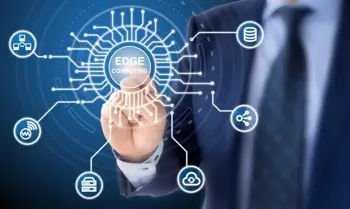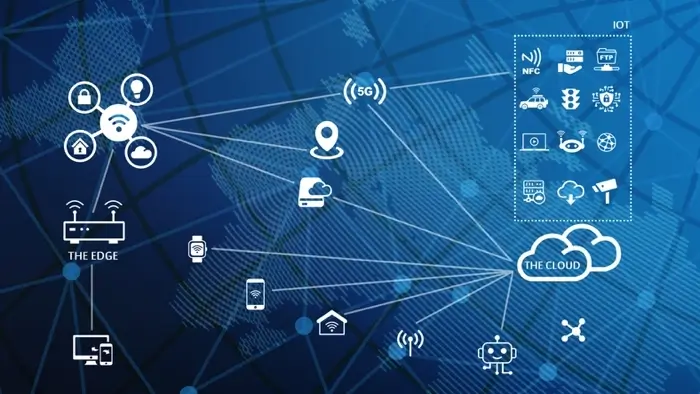What Is Edge Computing? How Edge Computing Works
Cloud computing has been around for several decades now, revolutionizing how people store and use data. However, it has limits. To solve bandwidth, latency, and offline issues, users can turn to edge computing instead.
Edge computing is a new way of processing data in real time. Learn what edge computing is, how it works, and how to differentiate it from cloud computing.
What is edge computing?
Edge computing is a distributed computing paradigm that brings data processing closer to the sources of data. Instead of relying solely on a centralized data server to do all the work, edge computing moves the computation as close to the edge of the network as possible.
In simple terms, edge computing crunches data right where it's collected. That means fewer processes run in the cloud. Processing mainly happens in local places, like on your phone, mobile device, computer, or Internet of Things (IoT) device.
Processing data locally minimizes sending large amounts of data to the cloud. This means that the main goal of edge computing is to reduce bandwidth requirements while saving network costs.
When data physically exists closer to the devices, gateways, or users who connect to it, it allows users to quickly and securely share data without latency.
Devices such as routers, gateways, and IoT-enabled devices are some edge devices that do edge computing daily. These devices have computing resources and can perform tasks locally without the need for constant Internet connectivity.

Many IoT applications require immediate responses, like automated systems in factories or self-driving cars. Edge makes a lot of sense in such applications where latency is critical.
Because information is power, organizations that effectively use data to gain insights, make informed decisions, and optimize operations have a significant competitive advantage. However, the velocity of data being generated can be overwhelming. Traditional cloud computing struggles to handle the real-time nature of this data.
Network limitations like latency issues collectively hinder data management efforts. In response to data challenges, modern businesses are shifting edge computing architecture. Today, edge computing is not only reshaping business computing, but also information technology as a whole.
How does edge computing work?
Traditionally, data travels from devices like your phone to a central data center for processing. This can create delays, especially with tons of devices generating data constantly.
Edge computing decentralizes data processing and storage, bringing computational capabilities closer to where data is generated. It solves three network challenges: bandwidth, latency, and congestion.
- Bandwidth refers to the amount of data that can transfer over a connection in a specific time. It measures in bits per second.
- Latency refers to the delay between sending and receiving data over a network.
- Congestion happens when a network has more data trying to flow through than it can handle.
It begins with generating data at various endpoints, such as sensors, IoT devices, or edge servers. These endpoints are responsible for collecting data from their immediate environment.
The data collected is then processed locally on edge devices located near the data source first. Then, the data undergoes initial processing and analysis directly on these edge devices. This processing involves filtering out irrelevant data, performing basic analytics, or even running machine learning algorithms to extract meaningful insights.
The devices often possess local storage capabilities, too. They store relevant data for quick access and reduce the need to constantly transfer data to centralized servers.
One of the key advantages of edge computing is its ability to enable real-time decision making. It puts storage where the data is. Edge devices can autonomously trigger actions without needing to wait for instructions.
Edge computing isn't here to replace the cloud, though. It can exist in conjunction with the cloud. Many solutions utilize both - for example, preprocessing data at the edge and then sending the aggregated data to the cloud for training machine learning models.
Why is edge computing important?
Edge computing is important because it offers several key benefits that make it an important component of modern computing systems. The benefits of edge computing include:
- Lower latency. Latency issues happen because the data has to travel long distances between you and faraway cloud data centers. Edge computing brings the cloud closer to your devices, reducing latency. This is crucial for real-time applications like autonomous cars or industrial automation.
- Bandwidth savings. By processing data at the source, less data is needed to be sent across networks to data centers. Edge saves bandwidth. Only the most relevant data is sent to the cloud for additional processing.
- Increased security. Edge is designed with security in mind. Sensitive data doesn't have to travel to a centralized cloud where it may be vulnerable. Industries dealing with confidential information should deploy edge computing systems.
- Improved reliability. Edge computing doesn't rely on connectivity to centralized data centers or servers. If there's a network outage, edge devices can continue operating. It does well in remote locations with unreliable Internet.
- Scalability. Edge computing allows for the flexible development of computing resources based on demand. As the number of connected devices increases, data volume increases. Edge computing enables efficient processing without overwhelming the central cloud infrastructure.
- Lower costs. The new technology reduces costs associated with data transmission, storage, and processing in the cloud. Companies optimize their resource utilization by offloading computation to the edge.
- Support for IoT and edge devices. Edge provides a real-time framework for managing data generated by IoT devices and edge sensors.
What are examples of edge devices?
Edge computing relies on edge devices that have their own computing resources. The devices act as data collection points and analyze data in real time at the edge of the network.
Some edge devices include:
- IoT sensors. These devices collect data from various sources, such as environmental sensors, smart home devices, or industrial sensors.
- Smart applications. Smart meters or thermostats function as edge devices, collecting and processing data locally.
- Gateways. Gateways act as intermediaries between edge devices and the cloud. They enable local data aggregation before sending it to the cloud for further analysis.
- Routers. Routers play a crucial role in edge computing by facilitating communication between edge devices and the cloud.
Edge vs. cloud computing
Cloud computing and edge computing are related concepts with distinct characteristics. While there is some overlap in their functionalities, they aren't interchangeable terms.
Both are related in that they all involve processing data in distributed computing environments. The key difference, however, lies in the location of the resources within the network architecture.
Edge computing
In edge computing, computational tasks are performed on devices or "edges" found near the data source. This setup works because it allows for data processing to occur close to the data source, optimizing performance. Generally, edge makes partial use of local drives.
Examples include installing servers and storage atop a wind turbine to process sensor data. Another practical scenario is placing computing resources at a railway station to analyze track and rail traffic sensor data.
The processed results can then be sent to another data center for further analysis, archiving, and integration with other datasets.
Cloud computing
Cloud computing is the on-demand delivery of computing services like servers, storage, or databases over the Internet rather than having them on your physical devices. Unlike edge, the cloud prefers using remote data centers for storage.
Users can access resources remotely through the Internet via a web browser most of the time. You pay only for the resources you use. Therefore, there's no large upfront investments in hardware and software.
In practice, cloud computing substitutes traditional data centers. It has been deployed to unlock the full potential of the Internet of Things in the past few years. Cloud platforms offer a framework for developing and deploying IoT applications seamlessly. While it analyzes vast amounts of data generated by IoT devices, the edge handles on-device processing and real-time actions.
However, cloud computing has shortcomings. It introduces latency due to the physical distance between users and the data centers where cloud services are hosted.

What is fog computing?
Like the edge, fog computing aims to bring cloud-like capabilities to a location where data is produced. It's seemingly an extension of edge computing. The exciting thing is that fog involves wider geographical distributioon than edge.
A series of fog nodes are used for performing local processing and storage. While the system is still evolving, fog computing holds immense potential in various fields.
Edge computing use cases
Ideally, edge computing puts computation and storage at the same point as the data source at the network edge. Here are some examples of edge computing in action.
- Industrial Internet of Things. In factories, sensors collect data on machine performance, temperature, and other factors. Edge computing allows this data to be processed and analyzed locally, thus enabling real-time decision-making.
- Smart cities. Traffic cameras process video locally to detect congestion and optimize traffic flow in cities. That way, it's easier to adjust traffic lights or send alerts about pollution levels.
- Autonomous cars. Edge computing is also crucial for the successful deployment of autonomous vehicles. The cars generate massive amounts of data that need quick processing without waiting for instructions from a server to heighten passenger safety.
- Retail. Retailers use edge computing to do data analysis regarding the stores. This data improves store layout, optimizes pricing, and personalizes the shopping experience.
- Healthcare. Wearable health monitors check heart rate and other biometrics on-device, providing immediate alerts to healthcare providers.
Challenges of edge computing
Although this type of computing offers many advantages, it's fairly far from being foolproof. It presents certain challenges, including:
- Security concerns. Edge computing can increase attack factors. The addition of IoT devices in the mix creates new opportunities for cyber threats, as most of them are notoriously insecure. Edge devices also operate in distributed and uncontrolled environments.
- Deployment issues. Deploying edge computing infrastructure across geographically dispersed locations can be complex. The technology is costly as well because it requires extra local hardware.
- Incomplete data. It refers to situations where edge devices cannot access the full dataset required for accurate analysis. This can occur due to various reasons, including intermittent connectivity and limited storage capacity.
Mitigating these challenges requires a holistic approach that combines technical innovation, robust architecture design, and effective management practices.
The emergence of new technologies, like the 5G network, unlocks edge computing's potential. It guarantees data transmission at the edge to enable devices to make autonomous decisions.
Frequently asked questions
What is network edge?
A network edge refers to the boundary or periphery of a network where data enters or exits the network. It's essentially the meeting point between your private network and the wider world.
What is mobile edge computing?
Mobile edge computing by definition is the processing of data produced by edge devices and applications close to the point of capture. Essentially, it extends the edge of your network.
Where is edge in edge computing?
The edge refers to the central location where data is generated and processed, typically at or near the source of data production.
What is an example of edge computing?
An example of edge computing is the use of a smart sensor in a factory to analyze data locally on temperature. It detects overheating before cloud analysis, preventing machine failure in milliseconds.